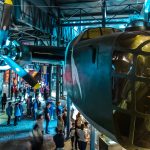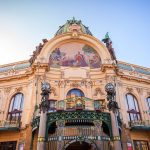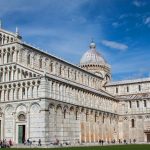
California tourist attractions
California is a state in the Western region of the United States. It borders Oregon to the north, Nevada and Arizona to the east, and the Mexican state of Baja California to the south; it has a coastline along the Pacific Ocean to the west. With over 38.9 million residents across a total area of approximately 163,696 square miles (423,970 km2), it is the most populous U.S. state, the third-largest U.S. state by area, and the most populated subnational entity in North America.
The Greater Los Angeles and San Francisco Bay areas in California are the nation’s second and fifth-most populous urban regions respectively. Greater Los Angeles has over 18.7 million residents and the San Francisco Bay Area has over 9.6 million residents.Los Angeles is the state’s most populous city and the nation’s second-most populous city. San Francisco is the second-most densely populated major city in the country. Los Angeles County is the country’s most populous county, and San Bernardino County is the nation’s largest county by area. Sacramento is the state’s capital city.
1.San Francisco and the Golden Gate Bridge

The Golden Gate Bridge is a suspension bridge spanning the Golden Gate, the one-mile-wide (1.6 km) strait connecting San Francisco Bay and the Pacific Ocean. The structure links the U.S. city of San Francisco, California—the northern tip of the San Francisco Peninsula—to Marin County, carrying both U.S. Route 101 and California State Route 1 across the strait. It also carries pedestrian and bicycle traffic, and is designated as part of U.S. Bicycle Route 95. Recognized by the American Society of Civil Engineers as one of the Wonders of the Modern World, the bridge is one of the most internationally recognized symbols of San Francisco and California.
The idea of a fixed link between San Francisco and Marin had gained increasing popularity during the late 19th century, but it was not until the early 20th century that such a link became feasible. Joseph Strauss served as chief engineer for the project, with Leon Moisseiff, Irving Morrow and Charles Ellis making significant contributions to its design. The bridge opened to the public in 1937 and has undergone various retrofits and other improvement projects in the decades since.
One of the most beautiful cities in America, San Francisco should be on everyone’s must-see list. The ocean and hills provide a stunning natural setting, but the quaint neighborhoods, historic sites, green spaces, inspiring cultural institutions, and relaxed attitude are what truly make this city special.
The iconic Golden Gate Bridge is one of the key sights and what many people call to mind when they think of the San Francisco, and even California. The orange frame against the blue water of San Francisco Bay, or rising out of the fog that often covers the area is an unforgettable sight. You can appreciate the bridge from afar or, for a more personal experience, drive over it, walk on it, or even bike across it.
2.Yosemite National Park

Yosemite National Parkis a national park in California.It is bordered on the southeast by Sierra National Forest and on the northwest by Stanislaus National Forest. The park is managed by the National Park Service and covers 759,620 acres (1,187 sq mi; 3,074 km2)in four counties – centered in Tuolumne and Mariposa, extending north and east to Mono and south to Madera. Designated a World Heritage Site in 1984, Yosemite is internationally recognized for its granite cliffs, waterfalls, clear streams, giant sequoia groves, lakes, mountains, meadows, glaciers, and biological diversity. Almost 95 percent of the park is designated wilderness. Yosemite is one of the largest and least fragmented habitat blocks in the Sierra Nevada.
Its geology is characterized by granite and remnants of older rock. About 10 million years ago, the Sierra Nevada was uplifted and tilted to form its unique slopes, which increased the steepness of stream and river beds, forming deep, narrow canyons. About one million years ago glaciers formed at higher elevations. They moved downslope, cutting and sculpting the U-shaped Yosemite Valley.
Yosemite National Park in Northern California is one of the United States’ most scenic and most visited national parks. The mountains, valleys, rivers, and spectacular waterfalls have drawn tourists, artists, and athletes here for decades. For nature lovers, a visit here is one of the best things to do in California.
Most of the key sights and things to do in Yosemite National Park are in Yosemite Valley. Carved by glaciers during the last ice age, the granite walls and huge waterfalls are some of the most outstanding features in the park. This is where you’ll find the big name attractions, like Yosemite Falls, Half Dome, and El Capitan.
3.Disneyland

Disneyland is a theme park at the Disneyland Resort in Anaheim, California. It was the first theme park opened by The Walt Disney Company and the only one designed and constructed under the direct supervision of Walt Disney, and opened on July 17, 1955.
Disney initially envisioned building a tourist attraction adjacent to his studios in Burbank to entertain fans who wished to visit; however, he soon realized that the proposed site was too small for the ideas that he had. After hiring the Stanford Research Institute to perform a feasibility study determining an appropriate site for his project, Disney bought a 160-acre (65 ha) site near Anaheim in 1953. The park was designed by a creative team hand-picked by Walt from internal and outside talent. They founded WED Enterprises, the precursor to today’s Walt Disney Imagineering. Construction began in 1954 and the park was unveiled during a special televised press event on the ABC Television Network on July 17, 1955. Since its opening, Disneyland has undergone expansions and major renovations, including the addition of New Orleans Square in 1966, Bear Country in 1972, Mickey’s Toontown in 1993, and Star Wars: Galaxy’s Edge in 2019. Additionally, Disney California Adventure Park opened in 2001 on the site of Disneyland’s original parking lot.
Disneyland, located in Anaheim, is California’s premier family destination and one of the top family vacation destinations in the US. This massive amusement park is home to all kinds of rides, games, shows, and entertainment, complete with restaurants and hotels. The park is a combination of theme rides and recreated worlds and cultures. You can find shows and other entertainment designed for both children and adults.
Long line ups and wait times have been reduced somewhat by the invention of FastPass+, which gives you the ability to book specific ride times, a hug with a character, and entertainment events. However, when kids are out of school, either for the summer, Christmas, spring break, or any other holiday, you can be sure that the park will be very busy.
4.Death Valley National Park

Death Valley National Park is an American national park that straddles the California–Nevada border, east of the Sierra Nevada. The park boundaries include Death Valley, the northern section of Panamint Valley, the southern section of Eureka Valley and most of Saline Valley.
The park occupies an interface zone between the arid Great Basin and Mojave deserts, protecting the northwest corner of the Mojave Desert and its diverse environment of salt-flats, sand dunes, badlands, valleys, canyons and mountains.
Death Valley is the largest national park in the contiguous United States, as well as the hottest, driest and lowest of all the national parks in the United States. It contains Badwater Basin, the second-lowest point in the Western Hemisphere and lowest in North America at 282 feet (86 m) below sea level. More than 93% of the park is a designated wilderness area.
Death Valley National Park contains some of California’s most inhospitable terrain, with extreme heat that has left this desert area strangely beautiful. Salt fields, dry parched land, sand dunes, mountains, unique rock formations, and a lake that lies below sea level create a unique landscape in this remote valley.
Some of the easiest to reach highlights in Death Valley are the sand dunes near Stove Pipe Wells, Badwater Basin, Zabriskie Point, and Dantes View. These and others are all easy to reach with a regular vehicle. If you have a 4WD vehicle, you can head out to more remote places like The Race Track.
5.Big Sur
Big Sur (/ˈsɜːr/) is a rugged and mountainous section of the Central Coast of the U.S. state of California, between Carmel Highlands and San Simeon, where the Santa Lucia Mountains rise abruptly from the Pacific Ocean. It is frequently praised for its dramatic scenery. Big Sur has been called the “longest and most scenic stretch of undeveloped coastline in the contiguous United States”, a sublime “national treasure that demands extraordinary procedures to protect it from development”, and “one of the most beautiful coastlines anywhere in the world, an isolated stretch of road, mythic in reputation”. The views, redwood forests, hiking, beaches, and other recreational opportunities have made Big Sur a popular destination for visitors from across the world. With 4.5 to 7 million visitors annually, it is among the top tourist destinations in the United States, comparable to Yosemite National Park, but with considerably fewer services, and less parking, roads, and related infrastructure.
This beautiful stretch along the Central Coast of California offers a chance to get back to nature. Camping and hiking at Garrapata State Park and Pfeiffer Big Sur State Park are some of the best places for these pursuits.
Big Sur begins about four miles south of Carmel in Yankee Point and stretches along the Highway No. 1 as far as Salmon Cove, some 17 miles north of San Simeon. This scenic road offers splendid views over the picturesque coastline. To the east stretches a true wilderness – the Santa Lucia Mountains and Ventana Forests, with more than 220 miles of trails.
Pfeiffer Big Sur State Park is a great place for hikers, sunbathers, and those looking for a nature escape. The park has camping facilities and, for anyone looking for a little more comfort, the Big Sur Lodge offers a peaceful retreat in a superb location. One of the highlights in the park is Pfeiffer Falls, which is reached by the Valley View Trail. A branch off this trail leads to the Valley Overlook with views that extend to the ocean and the Big Sur River Valley.
6.Lake Tahoe

Lake Tahoe (/ˈtɑːhoʊ/; Washo: Dáʔaw) is a freshwater lake in the Sierra Nevada of the Western United States, straddling the border between California and Nevada. Lying at 6,225 ft (1,897 m) above sea level, Lake Tahoe is the largest alpine lake in North America. and at 122,160,280 acre⋅ft (150.7 km3) it trails only the five Great Lakes as the largest by volume in the United States. Its depth is 1,645 ft (501 m), making it the second deepest in the United States after Crater Lake in Oregon (1,949 ft or 594 m).
The lake was formed about two million years ago as part of the Lake Tahoe Basin, and its modern extent was shaped during the ice ages. It is known for the clarity of its water and the panorama of surrounding mountains on all sides. The area surrounding the lake is also referred to as Lake Tahoe, or simply Tahoe; its English name is derived from its Washo name, Dáʔaw. More than 75% of the lake’s watershed is national forest land, covered by the Lake Tahoe Basin Management Unit of the United States Forest Service.
Lake Tahoe is a major tourist attraction in both Nevada and California. It is home to winter sports, summer outdoor recreation, and scenery enjoyed throughout the year. Snow and ski resorts are a significant part of the area’s economy and reputation. The Nevada side also offers several lakeside casino resorts, with highways providing year-round access to the entire area.
Stunning Lake Tahoe lies high in the Sierra Nevada mountain range and is a popular year-round vacation destination in California. Lake Tahoe is about more than just the lake, it’s the forests and mountains, small towns, and multitude of activities the area offers.
The blue lake, with its turquoise coves and surrounding mountains, is a summer playground for boaters, beach goers, campers, and nature lovers. The beautiful beaches and shallow coves are some of the main draws for families visiting the area in summer. Places like D.H. Bliss State Park and Kings Beach State Recreation Area are popular beaching destinations around Lake Tahoe.
7.Sequoia and Kings Canyon National Parks

Sequoia National Park is an American national park in the southern Sierra Nevada east of Visalia, California. The park was established on September 25, 1890, and today protects 404,064 acres (631 sq mi; 163,519 ha; 1,635 km2)[2] of forested mountainous terrain. Encompassing a vertical relief of nearly 13,000 feet (4,000 m), the park contains the highest point in the contiguous United States, Mount Whitney, at 14,505 feet (4,421 m) above sea level. The park is south of, and contiguous with, Kings Canyon National Park; both parks are administered by the National Park Service together as Sequoia and Kings Canyon National Parks. UNESCO designated the areas as Sequoia-Kings Canyon Biosphere Reserve in 1976.
The park is notable for its giant sequoia trees, including the General Sherman tree, the largest tree on Earth by volume. The General Sherman tree grows in the Giant Forest, which contains five of the ten largest trees in the world. The Giant Forest is connected by the Generals Highway to Kings Canyon National Park’s General Grant Grove, home of the General Grant tree among other giant sequoias. The park’s giant sequoia forests are part of 202,430 acres (316 sq mi; 81,921 ha; 819 km2) of old-growth forests shared by Sequoia and Kings Canyon National Parks. The parks preserve a landscape that was first cultivated by the Monache tribe, the southern Sierra Nevada before Euro-American settlement.Home to the largest trees on Earth, Sequoia and Kings Canyon National Parks are bucket-list destinations. The sequoias here are the largest living things in the world, and many of them are more than 2,000 years old, with some even more than 3,000 years old.
These adjacent parks cover an area of mountains with majestic granite peaks, deep gorges, lakes, rivers, and forests, but they are quite different from each other. If you are planning on visiting both parks, you will need at least a couple of days.
Although both parks are home to the giant sequoias, Sequoia National Park is arguably the best place to visit these ancient wonders. Easy walking trails, many of them paved, meander through the trees and provide easy access to the major sites. This park is also home to Mt. Whitney, which at 14,495 feet is the highest mountain in the US (apart from Alaska).
You can find some beautiful campgrounds in Sequoia National Park, many of which are well positioned for visiting the trees and other attractions, like Moro Rock, and the famous giant sequoia known as General Sherman Tree.










